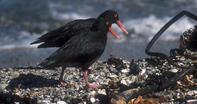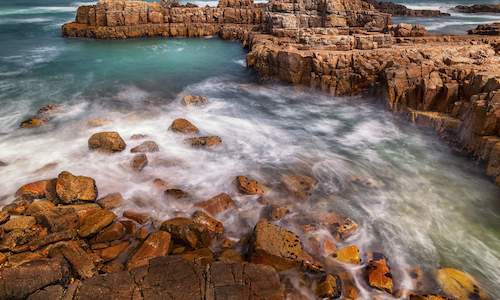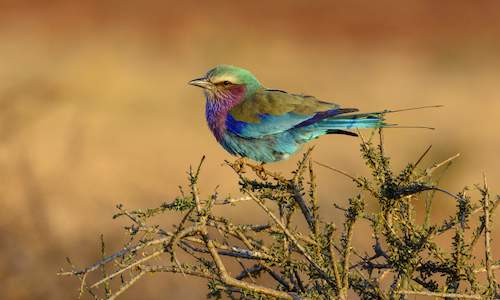
Name
African Black Oystercatcher (Haematopus moquini)Family
HaematopodidaeLength
51 cmAppearance
The adult oystercatcher is entirely black with bright red eyes surrounded by an orange ring. The wedge-like orange-tipped red bill is somewhat longer than the head and the mandibles do not meet at the tip.
The sides of the bill are compressed to form thin blades at the tip. The three-toed legs are short and red. The immature oystercatcher is a duller mottled brown-black with a white underpart and brownish-orange legs.
African Black Oystercatcher Diet
Their diet consists of mussels, limpets, polychaetes (worms), whelks and crustaceans. The powerful neck muscles and long blade shaped bill is specifically adapted to jab between the partly opened valves of mussels to get the flesh out.African Black Oystercatcher Call
The African black oystercatcher produces a clear repeated ‘klee-weep’ sound to communicate. When in danger the alarm call is a series of sharp ‘pip pip pip’ sounds.African Black Oystercatcher Breeding
Breeding time in South Africa is from October to March. The females lay one to four eggs in a simple shallow nest in the ground excavated in sandy soil and lined with rocks, bits of debris or a few pieces of broken shells.
The eggs are stone-coloured, with blotches varying from pale purple to dark blackish brown. The eggs are incubated by both parents for about 28-30 days and the chicks are unable to fly until about 45 days old.
 The Gouritsmond Beach is a sandy stretch of extraordinary beauty. It is a Blue Flag beach, and is family-friendly, and kids can safely swim,...
The Gouritsmond Beach is a sandy stretch of extraordinary beauty. It is a Blue Flag beach, and is family-friendly, and kids can safely swim,... SouthAfrica.co.za provides informative, educational content on many South African bird species that orthologists and bird-watchers would enj...
SouthAfrica.co.za provides informative, educational content on many South African bird species that orthologists and bird-watchers would enj...